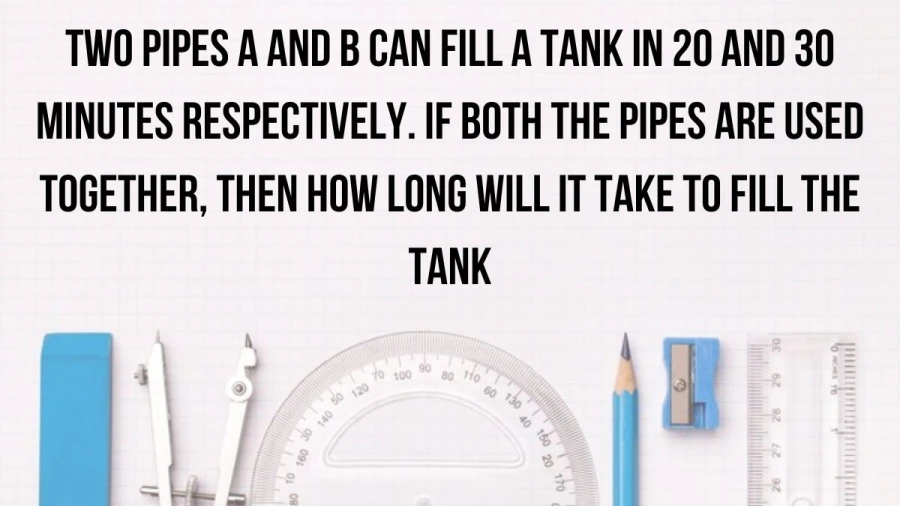If you happen to be viewing the article Two pipes A and B can fill a tank in 20 and 30 minutes respectively. If both the pipes are used together, then how long will it take to fill the tank? ? on the website Math Hello Kitty, there are a couple of convenient ways for you to navigate through the content. You have the option to simply scroll down and leisurely read each section at your own pace. Alternatively, if you’re in a rush or looking for specific information, you can swiftly click on the table of contents provided. This will instantly direct you to the exact section that contains the information you need most urgently.
Two pipes A and B can fill a tank in 20 and 30 minutes respectively. If both the pipes are used together, then how long will it take to fill the tank?
It will take 12 minutes to fill the tank when both pipes are used together.
To solve this problem, we can use the concept of the rate of work. Let’s denote the rate at which pipe A fills the tank as “1 tank per 20 minutes” and the rate at which pipe B fills the tank as “1 tank per 30 minutes”.
Article continues below advertisement
When both pipes are used together, their rates add up:
Combined rate = 1/20 + 1/30.
To find out how long it will take to fill the tank when both pipes are used together, we’ll calculate the time required for this combined rate to fill 1 tank.
Time taken = 1 / Combined rate
Time taken = 1 / (1/20 + 1/30)
Time taken = 1 / ((3/60) + (2/60))
Time taken = 1 / (5/60)
Time taken = 60 / 5
Time taken = 12 minutes
So, it will take 12 minutes to fill the tank when both pipes are used together.
Time and Work in Mathematics
Time and work problems are a common type of mathematical problem that involve determining the amount of work done by a group of people or machines working together over a certain period of time. These problems often involve finding the rate at which work is being done, and then using that information to calculate how long it will take to complete a task.
Article continues below advertisement
Article continues below advertisement
Here’s a basic approach to solving time and work problems:
-
Identify the rate of work: Determine how much work each person or machine can do per unit of time. This is often given in terms of work per hour or work per day.
-
Determine the total work: Figure out how much work needs to be done in total. This is usually given in some unit of work, such as units produced, distance traveled, or area covered.
-
Set up equations: Use the information given to set up equations that relate the rate of work to the total work and the time it takes to complete the task.
-
Solve the equations: Use algebraic techniques to solve the equations and find the unknown quantities, such as the time it takes to complete the task.
-
Check the solution: Make sure the solution makes sense in the context of the problem. For example, make sure the time calculated is reasonable given the amount of work and the rates at which it is being done.
Let’s illustrate this with an example:
Example: If it takes 8 hours for 4 machines to produce 600 units of a product, how many hours will it take for 6 machines to produce 900 units of the same product?
Solution:
-
Identify the rate of work: Each machine produces 600 / 8 = 75 units per hour.
-
Determine the total work: We need to produce 900 units.
-
Set up equations: Let x be the number of hours it takes for 6 machines to produce 900 units. So, 6x represents the total work done by 6 machines.
- Solve the equations: We know that the rate of work is 75 units per hour per machine. So, for 6 machines, the total work done is 6x = 75x. Solving for x:
6x = 900 => x = 900 / 6 = 150
So, it will take 150 hours for 6 machines to produce 900 units.
Check the solution: It takes longer with more machines, which makes sense intuitively.
That’s the basic approach to solving time and work problems in mathematics.
Thank you so much for taking the time to read the article titled Two pipes A and B can fill a tank in 20 and 30 minutes respectively. If both the pipes are used together, then how long will it take to fill the tank? written by Math Hello Kitty. Your support means a lot to us! We are glad that you found this article useful. If you have any feedback or thoughts, we would love to hear from you. Don’t forget to leave a comment and review on our website to help introduce it to others. Once again, we sincerely appreciate your support and thank you for being a valued reader!
Source: Math Hello Kitty
Categories: Math

